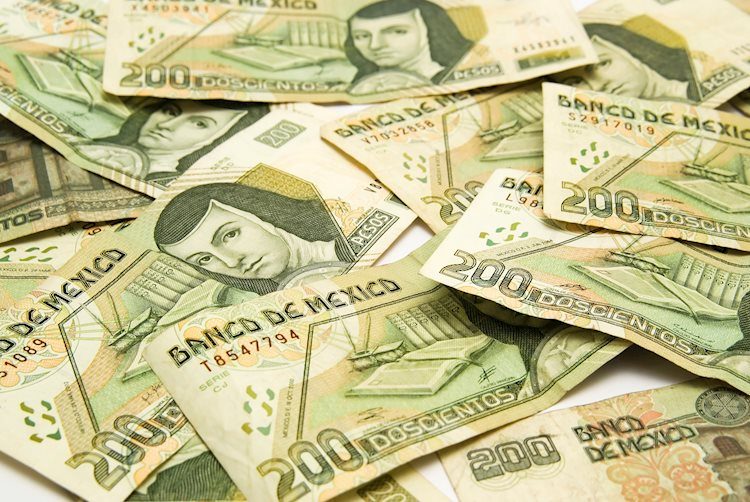- The Mexican peso is starting the week on the back foot, led by Fed Chairman Jerome Powell, who ignored Mexico’s quiet Constitution Day and shifted focus to inflation data and the upcoming Banxico rate decision.
- Strong US PMI and Nonfarm Payrolls suggest a Fed soft landing is achievable.
- Expectations are leaning towards holding Banxico rates at 11.25%, with eyes on Fed spokesmen for more information.
The Mexican peso is losing ground American dollar (USD) courtesy of Federal Reserve Chairman Jerome Powell over the weekend, sponsoring a jump in US Treasury yields. Along with a holiday in Mexico, this boosts the dollar amid the risk-on impulse. At the time of writing, USD/MXN is exchanging hands at 17.21, up 0.51%.
Mexico’s economic charter is blank for Mexico’s Constitution Day. This week, inflation data will be released on Wednesday, followed by the Bank of Mexico (Banxico) monetary policy decision on Thursday. Rates are expected to remain unchanged at 11.25%.
Meanwhile, the US economy continues to shine as the release of services PMIs from S&P Global and the Institute for Supply Management (ISM) showed that business activity is improving. That along with the US last Friday Non-agricultural wages data, increases the chances of Fed achieving a soft landing.
Meanwhile, some Federal Reserve spokesmen began crossing the wires after the Fed’s decision last Wednesday.
Daily roundup of market moves: Mexican peso on the defensive ahead of Banxico decision
- Inflation in Mexico will be released on Thursday ahead of Banxico’s decision. The Consumer Price Index (CPI) was 4.66% yoy in December and the core CPI was 5.09% yoy.
- The US S&P Global Services PMI came in at 53.4, beating estimates and previous data, while the Composite was 52, up from 50.9.
- The ISM Non-Manufacturing PMI, also known as services, rose from 50.5 to 53.4, beating estimates.
- S&P Global affirmed Mexico’s foreign currency rating of BBB and long-term local currency debt of BBB+.
- S&P Global confirmed that stable macroeconomic conditions, with real gross domestic product growth above 3% in 2023, supported by solid domestic demand and easing inflation, pave the way for the general election in June.
- Minnesota Fed President Neil Kashkari noted that a strong economy means the Fed is in no rush to cut interest rates. Kashkari acknowledged that inflation was making “rapid progress” toward the Fed’s 2% target, adding that policy could not be restrictive enough.
- Chicago Fed President Austan Goolsbee noted that inflation could continue to decline amid a strong U.S. economy,
Technical Analysis: Mexican peso weakens further as USD/MXN buyers target 17.20
USD/MXN is neutral and bounced off the 50-day simple moving average (SMA) at 17.13, although it fell short of gaining the 200-day SMA at 17.32. A daily close above 17:20 buyers with strong resistance could challenge the 200-day SMA, followed by the 100-day SMA at 17:40. The next rise lies at the value of 17.50.
On the other hand, if sellers pull prices below the 50-day SMA at 17:13, look for a challenge of the February 2nd daily low at 17:03 before it collapses to 17:00.
USD/MXN Price Action – Daily Chart
Frequently asked questions about the Mexican peso
The Mexican peso (MXN) is the most traded currency among its Latin American counterparts. Its value is largely determined by the performance of the Mexican economy, the policies of the country’s central bank, the amount of foreign investment in the country, and even the level of remittances sent by Mexicans living abroad, particularly in the United States. Geopolitical trends can also move the MXN: for example, the process of nearshoring – or the decision of some firms to relocate production capacity and supply chains closer to their home countries – is also seen as a catalyst for the Mexican currency, as the country is considered a key manufacturing center in the Americas. Another catalyst for MXN is oil prices, as Mexico is a key exporter of the commodity.
The main objective of Mexico’s central bank, also known as Banxico, is to keep inflation at low and stable levels (at or near its 3% target, which is the middle of the tolerance band between 2% and 4%). For this purpose, the bank sets a reasonable amount of interest rates. When inflation is too high, Banxico will try to tame it by raising interest rates, making it more expensive for households and businesses to borrow money, thus cooling demand and the overall economy. Higher interest rates are generally positive for the Mexican peso (MXN) as they lead to higher yields, making the country a more attractive place for investors. Conversely, lower interest rates tend to weaken the MXN.
The release of macroeconomic data is key to assessing the state of the economy and can impact the valuation of the Mexican peso (MXN). A strong Mexican economy based on high economic growth, low unemployment and high confidence bodes well for the MXN. Not only will this attract more foreign investment, but it may encourage the Bank of Mexico (Banxico) to raise interest rates, especially if this force is coupled with increased inflation. However, if economic data is weak, MXN is likely to depreciate.
As an emerging market currency, the Mexican peso (MXN) tends to be bullish during periods of risk, or when investors perceive broader market risks to be low and therefore seek higher risk investments. Conversely, MXN tends to weaken during times of market turbulence or economic uncertainty as investors tend to sell higher risk assets and flee to more stable safe havens.

